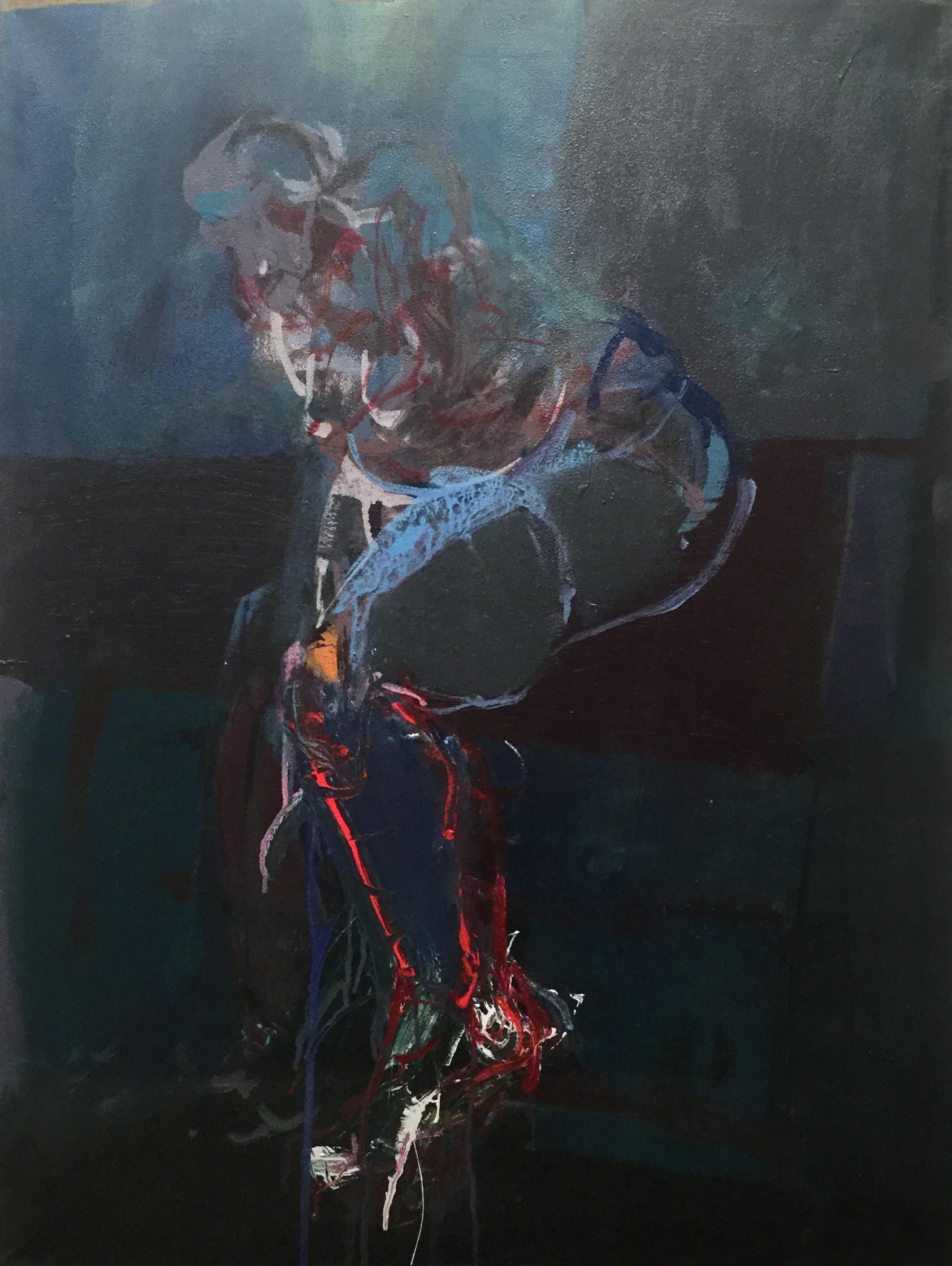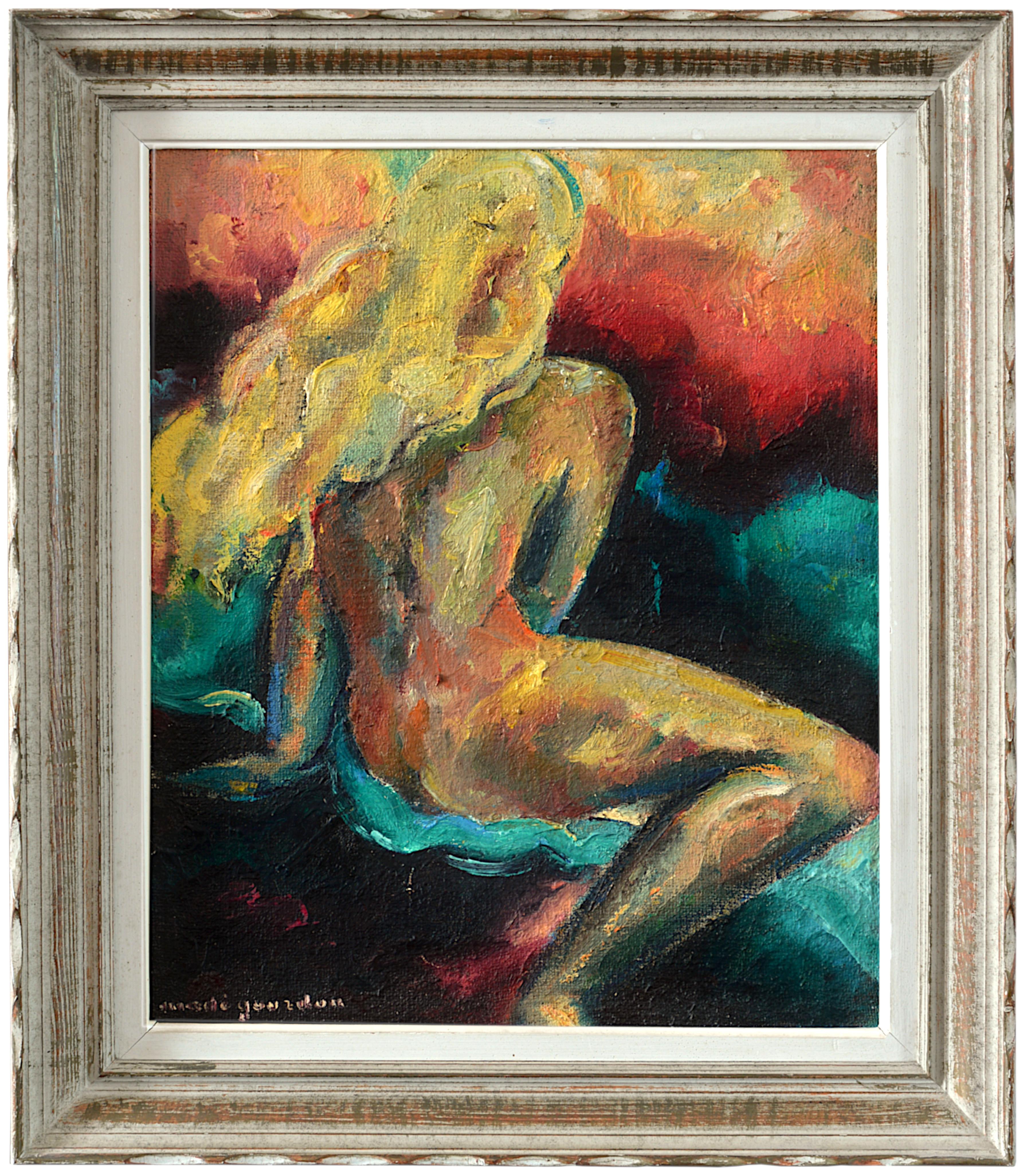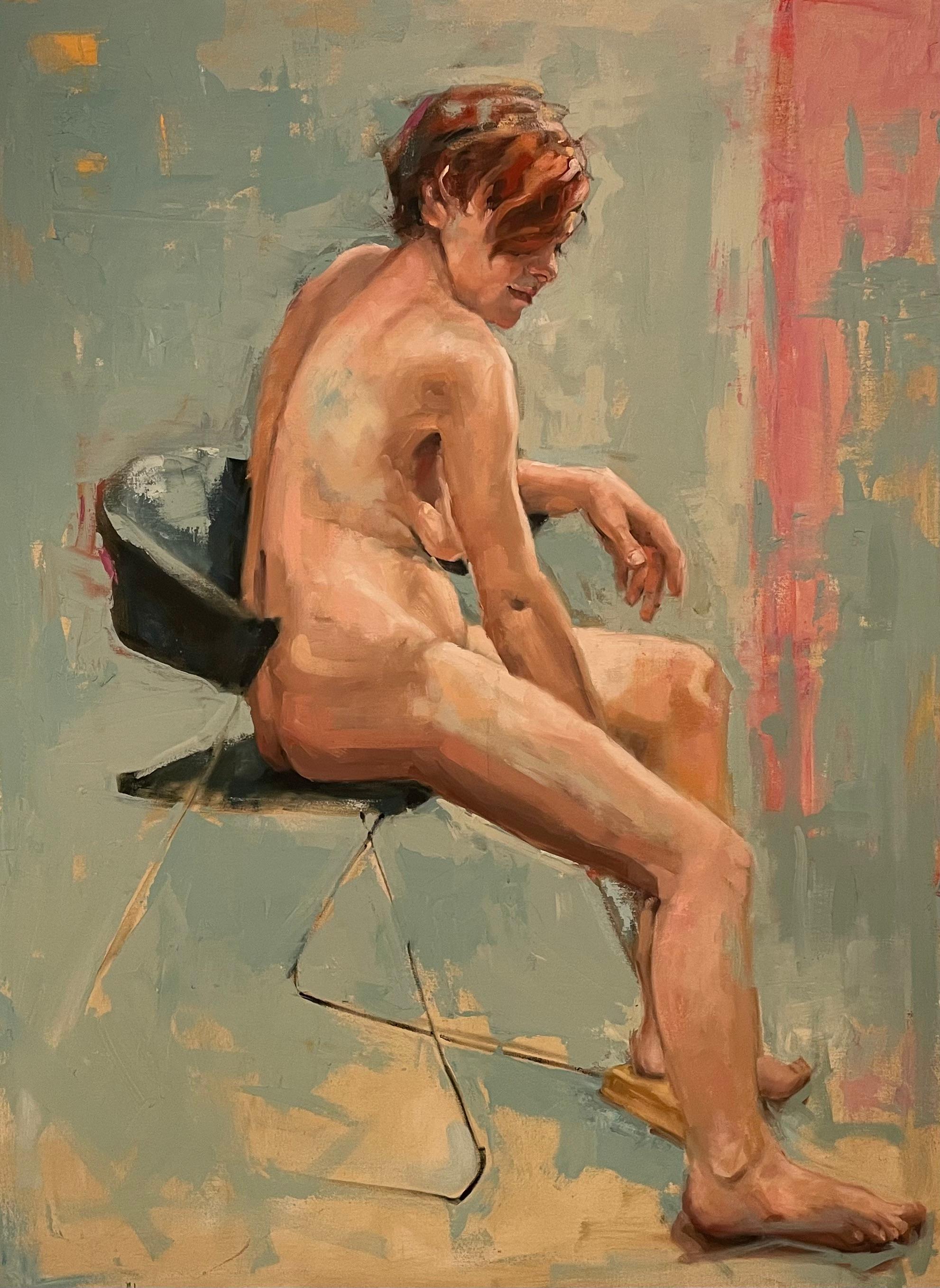Edgardo Corbelli " Orange Nude "Oil cm. 25 x 60 19521952
1952
About the Item
- Creator:Edgardo Corbelli (1918 - 1989, Italian)
- Creation Year:1952
- Dimensions:Height: 31.5 in (80 cm)Width: 17.72 in (45 cm)
- Medium:
- Movement & Style:
- Period:
- Condition:Framed cm. 52 x 87.
- Gallery Location:Torino, IT
- Reference Number:1stDibs: LU53733919602
Edgardo Corbelli
Edgardo Corbelli was an Italian artist born in Turin in 1918. From the traditional composition of the 1930s, the painting of Corbelli leads to technical and expressive results dominated by an impetuous sign assimilated, among others, by Oskar Kokoschka at the Salzburg Academy in 1958. This evolution comes to an expressionist language highly communicative that characterizes its landscapes, portraits and nudes. He was a part of numerous prestigious exhibitions in Italy and abroad. His works are a part of museums such as Musée Collégiale Saint Pierre le Puellier, Orléans, France and Musée Château de l’Empéri Volgograd Salon-de-Provence, France and Fine Arts Museum, Russia.
- ShippingRetrieving quote...Ships From: TORINO, Italy
- Return PolicyA return for this item may be initiated within 7 days of delivery.
- "Odalisque yellow" Oil , cm. 40 x 50 1937 free shippingBy Giulio da MilanoLocated in Torino, ITOdalisque ,yellow,orange, orient Giulio DA MILANO (Nizza, 1895 - Torino, 1990) Giulio Da Milano was a Giacomo Grosso's disciple and he was very close to the artists that used to patronize La Coupole de Montparnasse (from Kisling to Pascin, from Derain to Vlaminck). He is considered one of most representative exponents of the Turin’s artistic scene in the ‘30s-‘40s, close to the Gruppo dei Sei. His works can be found in the following museums: Turin, Modern Art Gallery...Category
1930s Expressionist Figurative Paintings
MaterialsCanvas, Oil
- "Donna con calze Rosse" Olio su cartone cm. 50 x 70 1984By Edgardo CorbelliLocated in Torino, ITFigura femminile con calze rosse Edgardo CORBELLI (Turin, 1918 - 1989) From the traditional composition of the 1930s, the painting of Corbelli leads to technical and expressive resu...Category
1980s Expressionist Figurative Paintings
MaterialsOil
- "Yellow odalisque" cm. 15 x 10 1925By Giulio da MilanoLocated in Torino, ITodalisque, yellow, orient Giulio DA MILANO (Nizza, 1895 - Torino, 1990) Giulio Da Milano was a Giacomo Grosso's disciple and he was very close to the artists that used to patronize...Category
1920s Expressionist Figurative Paintings
MaterialsOil
- "Red Odalisque" oil cm. 17 x 12 1947 Offer Free ShippingBy Giulio da MilanoLocated in Torino, ITred, odalisque,orange,yellow Giulio DA MILANO (Nizza, 1895 - Torino, 1990) Giulio Da Milano was a Giacomo Grosso's disciple and he was very close to the artists that used to patronize La Coupole de Montparnasse (from Kisling to Pascin, from Derain to Vlaminck). He is considered one of most representative exponents of the Turin’s artistic scene in the ‘30s-‘40s, close to the Gruppo dei Sei. His works can be found in the following museums: Turin, Modern Art Gallery...Category
1940s Expressionist Figurative Paintings
MaterialsWood Panel
- "Coppia-Passeggiata nell'acqua bassa" Olio cm. 90 x 110 2023By Birgitte Lykke MadsenLocated in Torino, ITWater,Swimmer,Summer,sea Birgitte LYKKE MADSEN (Odense, Denmark, 1960) 1981-86, Educated from the Academy of Fine Arts, Odense First solo exhibition in 1983 Artist statement: “I ...Category
2010s Other Art Style Figurative Paintings
MaterialsOil
- "Green apples on the table" Oil on wood cm. 63 x 25 1970By Enzo FARAONILocated in Torino, ITStill life, Apples, Green, Enzo FARAONI (S. Stefano Magra, La Spezia, 1920/2017) Enzo Faraoni is a great painter and engraver from Florence; he expresses the poetic everyday life o...Category
1970s Expressionist Still-life Paintings
MaterialsOil, Wood Panel
- Seated NudeBy Helge HelmeLocated in New York, NYAxel Henry Helge Helme (1894 Roskilde, Denmark 1987), Seated Nude, circa 1930, oil on canvas, original frame Son of a merchant, Helge Helme was admitted ...Category
20th Century Expressionist Nude Paintings
MaterialsOil, Canvas
- Female Nude Sitting Figure - Expressive Oil PaintingBy Agata Czeremuszkin-ChrutLocated in Salzburg, ATAgata Czeremuszkin-Chrut was born in 1983 in Czestochowa, Poland. She graduated from the Academy of the Fine Arts in Wroclaw (2008) with the Master degree in Painting. In 2007 she st...Category
2010s Expressionist Nude Paintings
MaterialsOil, Canvas
- Nandor Vagh Weinmann, Oil on cardboard, Naked Back, 1930sLocated in Saint Amans des cots, FROil on cardboard by Nandor VAGH WEINMANN (1897-1978), France, 1930s. Naked back. With frame: 64x56 cm - 25.2x22 inches ; without frame: 46x38cm - 18.1x15 inches. 8F format. Signed "Nandor V. Weinmann" lower left. In its Montparnasse frame. Very good condition. Born October 3, 1897 in Budapest, Nándor is the older brother of Elemer and Maurice Vagh-Weinmann. He came to Paris to present his work in 1931. He died on December 12, 1978 near Montereau (Seine-et-Marne) following an automobile accident. He is the most colorful of the three “expressionist” brothers. Painter of figures, landscapes, especially open mountains, and bouquets in bright colors. He is also a religious painter and then finds the tragic condition. Born in BUDAPEST on October 3, 1897, Nandor Vagh Weinmann belongs to a profoundly artistic people. Living in the heart of Central Europe where they came from Asia a millennium ago, the Hungarians have preserved a strong ethnic individuality whose mark is their very synthetic, non-Indo-European language. Resistant to secular invasions, they have kept the virtues of a very ancient humanity that have become rare in our modern world, especially since their way of life has remained essentially rural until today. In the arts they know how to express a generous, extreme sensibility and by the poetic verb, by the musical rhythms and also by a popular art of a richness, an exceptional harmony. Until the age of thirty-four, during the decisive years of childhood and youth, Nandor Vagh Weinmann was intimately imbued with popular life and the soul of Hungary. From the capital where his father was a jeweler and had a family of ten children, Nandor was the fifth, he knew first of all the suburbs, the populated districts, the rigors in winter of the cold and the snow. A very mobile existence made him acquainted with all of Hungary, from the Danube to Transylvania, its infinite plains and its wild mountains, its immense villages with ample low houses, and its towns which are still immense villages. The painter is passionate about rustic works, harvest scenes, beautiful folk costumes. Coming into direct contact with the peasants, he learned to know their soul. These contacts gave the artist a direct feeling for popular life and soul, as Millet once understood the peasants of Barbizon and Normandy whose existence he shared. What fascinated Nandor Vagh Weinmann above all were the festivals which enlivened the dreary life of the countryside, the circuses, the merry-go-rounds, the gypsies unleashing orgies of music, light and color. In the party, and especially the Hungarian party, the whole soul of a people, all its energy, its need for movement, for intensity, is expressed in its pure state and realizes the primary and essential form of what is called beauty. And as if melted at the party, there is the infinite steppe where herds of horses and oxen circulate where terrible storms sometimes roar where the seasons unfold their grandiose splendours. The young Nandor Vagh Weinmann nourishes his sensitivity to his inexhaustible shows, both eternal and always new, a sensitivity which very early declared itself that of a painter. Since the age of fourteen he painted, and since then he never stopped doing it. Two of his brothers Maurice, two years his junior, who had a remarkable career similar to that of Nandor and later Elemer who became Maurice's pupil, also devoted themselves to painting, despite family obstacles. And the three brothers united by a common passion worked together in Hungary and later in France. Painting was so much in the blood of the family, as in the past among the Veroneses, the Breughels, the Lenains, the Van Loos and so many other artistic dynasties, that three sons of the Vagh Weinmanns became painters in their turn. One of these, Emeric, son of Nandor, today occupies an important place in the contemporary school. Nandor, at fifteen, was a pupil of the Academy of Fine Arts in Budapest where he worked diligently, then at that of Vienna. He painted many portraits, but also landscapes, compositions and, by his relentless work, managed to live from his brush, although married very young and having to overcome many hardships. He therefore knew the hardships and miseries of life. These strongly impregnated his vision as an artist and explain the thrill of humanity that runs through all his work. A particularly moving experience was reserved for him at the age of twenty. In the hospitals of Budapest he had to paint extraordinary cases, operations, frightful wounds, the deformations to which our poor body is subjected by traumas and physiological decompositions. In these circumstances, it is not a question of gratuitous art, of formal research but of immediate, authentic expressions of our flesh and our being. We know that Breughel Velázquez and Goya had been haunted by the sight of cripples and of madmen Géricault by that of corpses. But life is ultimately stronger than anything, and it is life that Nandor Vagh Weinmann has passionately observed and translated through all the places where he has always painted on nature. Nothing stopped him. It happened to him to paint, for example in front of the mill of Linselles by a weather so cold, that nobody could stay outside, and that he did not leave the place before having finished his work. Because he works constantly on the ground, under the sky, in the silence he loves. His reputation is established. He exhibited at the national fair in Budapest, in the big cities of Hungary Szeged, Szombathely, Veszprém, Kaposvar. In 1931, like all artists in the world, he came to France. But unlike the others, he did not settle in Paris. Because Nandor Vagh Weinmann does not belong to this group of cosmopolitans that we call the School of Paris. He settled in Toulouse, where he remained for a long time with his brothers, and traveled throughout France, eager for new ties, exhibiting in the most diverse cities, in Bordeaux, Marseille, Lyon, Agen, Bayonne, Dax, Tarbes, Grenoble, Nice, Cannes, Strasbourg, Mulhouse, Colmar, Lille. He even crossed borders. He was in Saint Sebastian, in Geneva, and once in Egypt in 1927 where he painted King Fouad...Category
1930s Expressionist Figurative Paintings
MaterialsOil, Cardboard
- DreamLocated in Saint Amans des cots, FROil on canvas by Madé Gourdon, France, 1960s. "Dream". with frame: 70x61 cm - without frame: 55x46 cm. 10F format. Signed "Madé Gourdon" in the lower left. In its frame Montparnasse....Category
1960s Expressionist Figurative Paintings
MaterialsBurlap, Oil, Canvas
- "Young Woman Seated" Green & Pink Contemporary Figurative Nude by Shana WilsonBy Shana WilsonLocated in Carmel, CAIn "Nude Woman Seated," a 40" x 30" oil on wood panel by Shana Wilson, there is an intimate portrayal of vulnerability and quiet strength. The artist employs a soft, earth-toned palette, with shades of warm beige, muted greens, and accents of coral, to craft the figure’s delicate form. Wilson's loose, confident brushstrokes lend a raw, textured quality, while the interplay of light and shadow captures the natural curves of the human body. The solitary figure, caught in a moment of repose, exudes a contemplative air, inviting viewers to reflect on the complexities of the human form and the subtle narratives contained within stillness. About the Artist: Over seven billion souls exist on this planet, each with a unique face and story. Shana transfers her visceral love for the human landscape to canvas, tenderly cradling its peaks and valleys, darkness and light, colors and neutrals, empty and full, hard edges and soft curves. Each brush stroke creates a controlled cacophony as it assembles the intricate jigsaw of the human face. An entire life’s journey is written on this human landscape; a journey that begs to be documented and treasured. Shana’s legacy project is to paint inspirational women from all walks of life, inclusive of all cultures and orientations. The subjects all have one thing in common; the ability to inspire and create social change. She pays tribute to them on canvas, painting a long overdue celebration of trail-blazing women. Visit any major gallery or museum in the world and it is teeming with paintings of nude women...Category
21st Century and Contemporary Expressionist Figurative Paintings
MaterialsWood Panel, Oil
- Two ladies with glassesLocated in Wien, 9Gurami Hagemann was born in Tiblissi in Georgia in 1945. At the age of 15 he received his diploma in painting. From 1965 to 1971 he attended the Art Academy in Tiblissi. In 1993 he r...Category
20th Century Expressionist Nude Paintings
MaterialsCanvas, Oil




